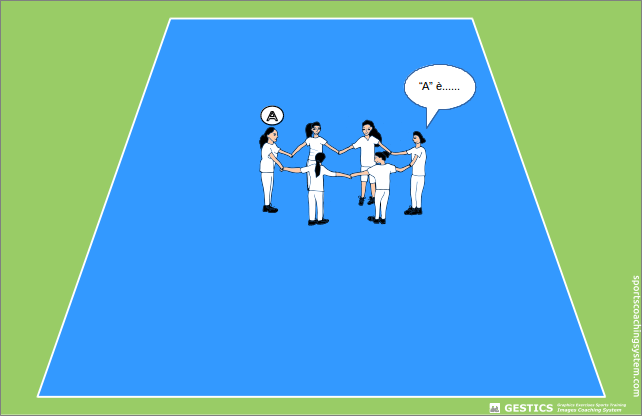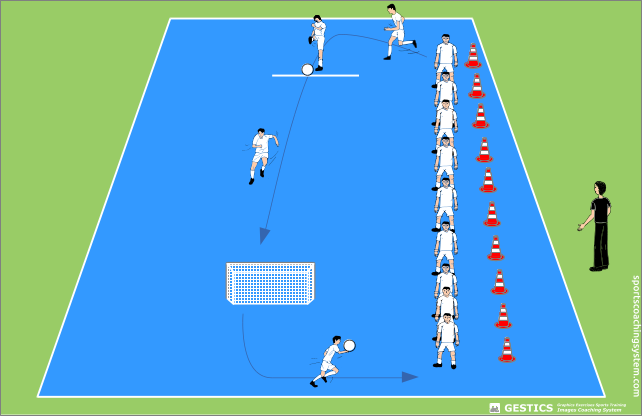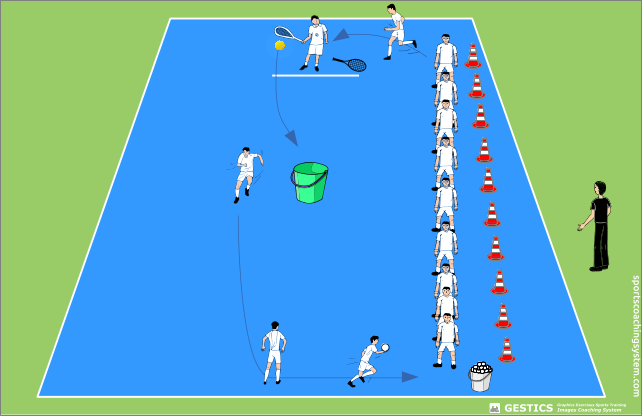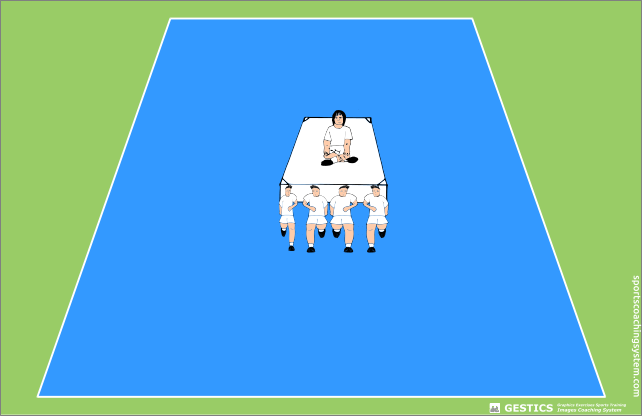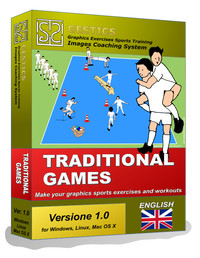Esercizio N: 0118 - basic physical and motor activity
gaits

HTTP://WWW.SPORTSCOACHINGSYSTEM.COM
SHORT DESCRIPTION:
START: in row behind the goal lines
TEAMS: both teams that no Free number of players per team
FIELD: It varies from m. Up to 10x10 m. 20x20, according to the age and abilities of participants
PURPOSE: finish first respecting the pace (or make the pace in the best way possible)
DESCRIPTION: the game can be done either in teams, forming two or three files and assigning a score to the team that single, putting the participants in line behind the end line and making them all set out together. Vine who first passes the line which is located on the opposite side of the field having complied with the proposed gait. The different gaits are: - The cat: kneeling on the ground, hands leaning forward, leaning alternately ambulate right hand and left knee and vice versa. - The dog, like the cat, but with her knees, ambulatory supporting hands and feet, slow pace or faster. - The rabbit: like the cat but carry on both knees and both hands then with slow motion. - the hare: like the cat but carry on both knees and then both hands with fast movement. - Iguana: like the cat but ambulate alternately placing his right hand and right knee and vice versa. - the horse trotting: ambulate as the dog but alternately placing his right hand and right foot and vice versa. - The galloping horse: ambulate as the dog but alternately placing hands and feet, no flight phase between two supports. - The Leopard: ambulate as the galloping horse but carrying out a phase of flight between the support of the hands and the feet. - Shrimp: by raising the basin, with belly up, ambulate on hands and feet going backwards, ie in the direction of the head. - The ant holding up the basin, with belly up, ambulate on hands and feet going forward, ie in the direction of the feet. - The crab (belly up): by raising the basin, with belly up, ambulate on hands and feet going sideways. - The crab (stomach): by raising the pelvis with his stomach, ambulate on hands and feet going sideways. - The frog: legs bent and spread apart, hands at his feet. Making a leap forward and fall on all fours, with a prevalence of foot, molleggiando. - The crocodile: Proni ground, fists behind, sliding forward only with the help of the elbows. - The Caiman: supine, his fists to his chest, back elbows resting on the carpet; putting strain on your elbows and move your body in the direction of the head. - The pace of Leopard (the lizard): crawling on the ground from the prone position, pushing on all 4 limbs (hands-elbows and knees-feet). - The rowing boat: sitting, legs bent, feet on the floor in the foot outlet. Push your feet moving back and simulating the act of rowing also with your hands. - The kangaroo: standing, legs together, arms bent with fists to his chest. Making continuous leaps forward. - The Ostrich: stand, ambulate forward to long distance. - The quail: standing, ambulate forward in very short steps, namely by supporting the heel immediately in contact with the toe of the foot. - The trunk in the water: prone on the ground with arms up, roll crosswise on themselves, in one direction and then the other. - The spinning wheel forwards: number of flipped forward. - The wheel turning back: number of flipped back. - The windmill blades: series of wheels. - The caterpillar: standing, torso tilted forward, hands resting on the ground; take small leaps forward first with his hands and then with their feet (dembulare forward and then backward). - The car that turns: quadruped prone position, ie hands and feet on the ground, raised basin. Moving laterally rolling, namely by passing quadruped prone position to the supine position and vice versa. - The dog sniffing prey on his knees with the butt raised, that is, with the femurs perpendicular to the ground, hands and arms resting on the ground and chest touches the ground. Ambulating forward (Slipping of the Klapp method). - The Giant: stride forward on his toes with arms stretched up. - Dwarves: stride forward with knees bent and hands on her hips. - The drunk who staggers: stride forward in a zig zag. - The sparrow lame: standing, gait hopping on one foot (first on one and then on the other), hands flitting to simulate the wings for a better balance seal. - Tank: like the trunk in the water but instead of just one child is run by two or three children embracing each other behind. - The leaves in the wind: the short part of the stroke, turn on themselves in a way (possible upside down), another short section of stroke, turn on themselves in the other direction (possible upside down), and so on
VARIANTS: The lame gait: repeat the various gaits by removing one or more points of appoggio.Andatura according to the number of blocks: say boys to make a gait own pleasure but on 3 support points (on 2 of 4 out of 5 of 6 etc. ...) according to the position gait: tell the kids to make a gait at will but prone, standing, supine, sitting, etc ... gait according to the direction: to tell the kids to make a stride forward at will but , back, side, etc ... gait according to the type of translocation: tell the kids to make a gait at will but walking, running, jumps, crawling, etc ...
TIPS: at the beginning it is better to start them in a row, two or three at a time to better control the pace that was performed correctly
MATERIAL:
Previous articles
|
Next articles
|


